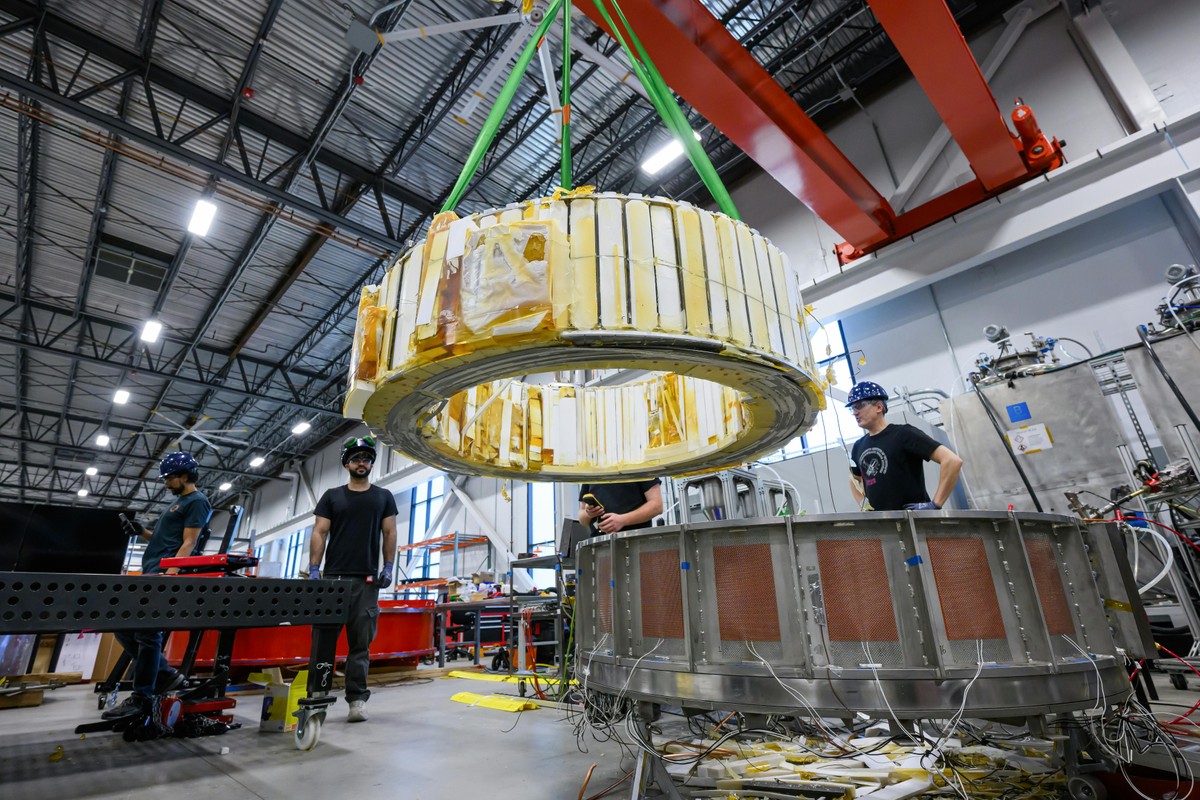Fusion Power Crosses the Commercial Rubicon as Eni Commits $1 Billion to Virginia Plant
Italian energy giant's massive offtake deal with Commonwealth Fusion Systems marks unprecedented validation of nuclear fusion as investable asset class
In the rolling hills of Chesterfield County, Virginia, a technology once confined to university laboratories and government research facilities is preparing to power the world's energy grid. Commonwealth Fusion Systems announced today that Italian energy major Eni has signed a power purchase agreement worth more than $1 billion for electricity from the company's first commercial fusion reactor, expected to come online in the early 2030s.
The deal represents far more than a single transaction between two companies. Market analysts describe it as the moment fusion energy transformed from scientific aspiration into commercial reality, attracting capital from both Silicon Valley tech giants and traditional energy incumbents seeking to hedge against an uncertain carbon-constrained future.

When Physics Meets Financial Engineering
The 400-megawatt ARC fusion plant at the center of this agreement promises to deliver what the energy industry has long sought: clean, baseload power that operates around the clock without weather dependency. Unlike solar and wind installations, fusion reactors can generate consistent electricity regardless of atmospheric conditions, addressing a critical gap in renewable energy portfolios.
CFS Co-founder and CEO Bob Mumgaard emphasized the significance of securing backing from established energy players. "Our fusion power attracts diverse customers across the world — from hyperscalers to traditional energy leaders — because of the promise of clean, almost limitless energy," he stated in the announcement.
Eni CEO Claudio Descalzi positioned the agreement as validation of fusion's industrial potential, describing it as "a turning point in which fusion becomes a full industrial opportunity." The Italian company has maintained a strategic investment in CFS since 2018, demonstrating unusual persistence in backing unproven technology.
The Demand Side Revolution
Behind this landmark transaction lies a fundamental shift in electricity markets. The PJM Interconnection, which serves Virginia and much of the Eastern United States, has experienced capacity price increases approaching 1000% in recent auctions. Dominion Energy forecasts load growth of 5.5% annually through 2039, driven primarily by data center expansion and artificial intelligence computing demands.
This surge reflects a broader challenge facing energy markets globally. Major technology companies have committed to 24/7 carbon-free electricity procurement, requiring power sources that can operate continuously unlike intermittent renewables. Amazon, Google, and Microsoft have collectively announced clean energy commitments exceeding 20 gigawatts, creating unprecedented demand for reliable zero-emission generation.
The timing proves particularly relevant as utilities struggle to balance growing electricity demand with decarbonization mandates. Traditional baseload coal plants face retirement schedules, while natural gas facilities confront increasingly stringent emissions regulations. Nuclear power, despite its carbon-free credentials, remains politically challenging and capital-intensive.
Supply Chain Bottlenecks Emerge as Critical Risk
While demand signals strengthen, fusion technology faces significant engineering and manufacturing constraints that could determine ultimate success. Industry experts point to high-temperature superconducting magnets as both enabling technology and potential bottleneck.
CFS relies on REBCO (Rare Earth Barium Copper Oxide) tape manufactured by a limited number of global suppliers, including Fujikura, SuperPower, and MetOx. These materials enable the compact reactor designs that make commercial fusion economically viable, but production capacity remains constrained.
Equally challenging is tritium fuel supply. The radioactive hydrogen isotope essential for fusion reactions exists in quantities measured in tens of kilograms globally. ARC reactors must achieve tritium breeding ratios exceeding 1.0, meaning they produce more tritium than they consume, to maintain fuel self-sufficiency.
"The demand side validation is extraordinary, but physics and materials science remain the binding constraints," noted one nuclear industry analyst familiar with fusion development. "Even minor delays in magnet manufacturing or blanket technology could push commercial operation timelines."
Capital Formation Accelerates Across the Sector
The Eni agreement joins a growing portfolio of fusion power purchase commitments that collectively exceed $3 billion. Google previously signed a 200-megawatt offtake agreement for the same ARC plant, while Microsoft committed to purchasing power from Helion Energy's proposed facility targeting 2028 operations.
This influx of customer commitments enables fusion companies to secure project financing and attract institutional investment. CFS recently completed an $863 million Series B2 funding round, with Eni increasing its stake as part of the transaction.
Traditional energy companies view fusion investments as strategic hedges against stranded fossil fuel assets. As governments implement increasingly aggressive decarbonization policies, early positions in breakthrough technologies offer potential protection against regulatory obsolescence.
Market Structure Implications
The emergence of utility-scale fusion capacity could reshape electricity market fundamentals. Unlike renewables that require storage or backup generation for grid reliability, fusion plants offer dispatchable power similar to conventional thermal facilities.
Regional transmission organizations may need to develop new market products specifically for 24/7 carbon-free electricity, potentially creating price premiums for continuous clean generation. PJM and other grid operators have begun examining capacity market reforms to better value reliability attributes.
Financial markets are responding with increased attention to fusion supply chain investments. Companies involved in superconducting materials, cryogenic systems, and specialized manufacturing equipment have begun citing fusion applications in investor presentations.
Investment Landscape Takes Shape
Professional investors seeking exposure to fusion commercialization face limited public market options. Most fusion developers remain privately held, though several equipment suppliers trade on major exchanges.
Coherent Corporation provides excimer lasers essential for REBCO tape production, while Linde and Air Liquide supply cryogenic systems for superconducting magnet cooling. Materion Corporation produces beryllium compounds used in molten salt blanket systems, though fusion applications represent small portions of current revenues.
Private equity and venture capital have deployed more than $7 billion across dozens of fusion companies since 2021, with valuations reflecting significant commercial premiums despite technical risks. Consolidation appears likely as capital concentrates around companies demonstrating engineering progress and customer traction.
Timeline Realities and Strategic Implications
Despite promotional timelines suggesting early 2030s commercial operation, industry observers anticipate delays in first-generation facilities. SPARC, CFS's demonstration reactor under construction in Massachusetts, must achieve first plasma before ARC construction can proceed with confidence.
Manufacturing capacity for critical components requires substantial lead times, while regulatory frameworks continue evolving. The Nuclear Regulatory Commission has adopted streamlined oversight for fusion facilities compared to traditional fission reactors, but permitting processes remain untested at commercial scale.
Successful fusion deployment could fundamentally alter global energy geopolitics. Nations controlling superconducting materials and manufacturing capabilities may achieve strategic advantages similar to those currently held by oil and gas producers.
The Eni-CFS agreement signals that fusion energy has crossed from laboratory curiosity to commercial product, attracting serious capital from established energy players. Whether this technological leap can overcome manufacturing constraints and timeline pressures will determine if fusion fulfills its promise as the ultimate clean energy solution.
For investors and energy market participants, the message appears clear: fusion power has evolved from science project to strategic imperative, demanding attention from professionals previously focused on conventional energy transitions.
House Investment Thesis
| Category | Key Analysis & Details |
|---|---|
| Core Thesis | The CFS-Eni deal is part of a real trend of fusion offtake agreements, driven by demand for clean, firm power. The binding constraint is not commercial demand but physics, supply chain, and engineering risks. Timelines are likely to slip, but early offtakes are rational as an option on baseload capacity in high-demand markets. |
| Deal Specifics (CFS-Eni) | - Project: 400 MW ARC fusion plant in Chesterfield County, VA (PJM Interconnection), targeting early 2030s. - Deal: ">$1B+" PPA from energy major Eni. - Context: Follows a 200 MW PPA with Google for the same plant. Local officials estimate project cost >$2.5B. |
| Evidence of Trend | - Helion → Microsoft: 50 MW PPA (target ~2028). - Type One Energy ↔ TVA: LOI for a utility-owned stellarator plant. - Why Now: Surging AI/data-center load in PJM (5.5% CAGR), 24/7 Carbon-Free Energy (CFE) mandates, favorable NRC regulation (Part 30), and technology milestones (e.g., CFS's 20T magnet demo). |
| Unit Economics (Modeled) | - $1B+ PPA Interpretation: Covers a slice of output, not the full plant. Model suggests ~$85/MWh for a 100 MW block is plausible, justifying a premium for firm 24/7 CFE given PJM's high capacity/congestion costs. |
| Key Risks & Constraints | 1. Blanket & Tritium: Highest risk. Unproven at scale; tritium breeding ratio (TBR≥1) and global supply are critical. 2. REBCO HTS Magnets: Manufacturing volume and tape supply chain (Fujikura, SuperPower) are chokepoints. 3. Heat Exhaust: Divertor reliability at MW/m² scales. 4. Schedule: Base case for ARC grid connection is mid-2030s (slippage from early 2030s). 5. Capital: FOAK capex >$2.5B. |
| Competitive Landscape | - CFS (Tokamak): Leading commercial momentum (site, permits, PPAs). - Helion (Magneto-inertial): Aggressive timeline, higher physics risk. - Type One (Stellarator): Utility-integrated model with TVA. - Others (TAE, etc.): Strong partnerships, further from PPAs. |
| Investment Angles (Upstream) | - Public Equities: HTS tape suppliers (Fujikura), equipment (Coherent), cryogenics (Linde), materials (Materion for beryllium). - Private Markets: REBCO manufacturing, tritium breeding systems, FLiBe chemistry supply chains. |
| Catalysts (Next 12-24 Mo.) | 1. SPARC construction milestones (first plasma ~2026). 2. ARC permitting and interconnect progress. 3. More PPA announcements. 4. NRC Part 30 rule finalization. 5. REBCO/FLiBe supply chain deals. |
| Predictions | 1. >$2-3B in new fusion offtakes by end-2026. 2. ARC COD shifts to mid-2030s. 3. Public suppliers will cite fusion as a driver by 2027. 4. More states will classify fusion as clean energy. 5. Industry consolidation to <20 meaningful developers by 2030. |
| Bottom Line | Demand is robust (PJM scarcity, 24/7 CFE). Supply is the governor (physics, materials). CFS is the commercial leader, but bottlenecks (REBCO, Tritium) dictate pace. Invest in enabling supply chain; view offtakes as options on premium clean capacity. |
NOT INVESTMENT ADVICE
